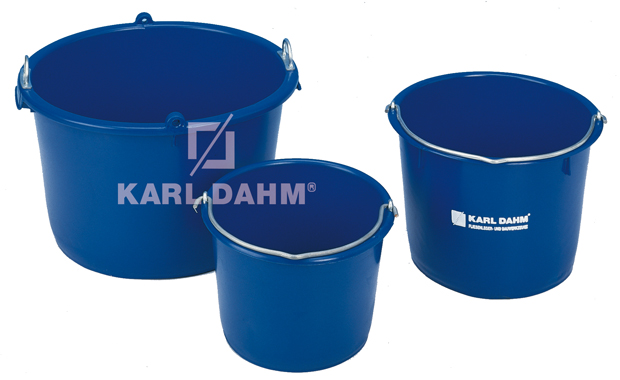Buy buckets from Karl Dahm in best quality. Mud bucket or construction bucket optimally applicable for the transport of heavy mud or glue residues. Buckets in different sizes, colors and shapes. Buckets and sludge buckets can be found in the Karl Dahm Online Shop in professional quality. Different buckets for different filling quantities, with or without handle, rectangular or round.
Buckets and sludge buckets
Buckets and sludge buckets help you to easily remove water and sludge from the building in the event of water damage. Buckets are usually made from certain plastics. These plastics are specially designed to withstand constant contact with water. Buckets are available in a wide variety of sizes and capacities, as well as in different shapes and colours.
The colour is probably the less important argument here, as colour is purely a matter of taste. The shape, however, has an effect on the area for which the buckets can best be used. Good quality is also an advantage for simple buckets and mud buckets. Especially when transporting heavy materials, the bucket must be strong and must not break or tear. It is advisable to buy a sturdy handle. We only recommend buying buckets without handles for large buckets. Large buckets should also have handles attached to the sides, for example, to enable problem-free transport.
The bucket and its history
Buckets have been used for centuries to transport various substances. The most common use is in the transport and storage of liquid substances. The plastic used today prevents the individual liquids from leaking out of the bucket. Early containers were made from clay or carved from wood. They were and still are particularly useful for carefully pouring out liquids. The function of the handle was also developed quite early on. The original name of the bucket comes from the Latin situlae. The existence of buckets goes back to the Middle Ages and has been proven.
Buckets - used by professionals
Today they are used a lot on building sites as they are a handy means of transport. They allow me to move and store many small parts from one place to another. However, buckets such as the mortar bucket or the construction bucket are also used as mixing buckets for different materials. Tile adhesive and joint levelling compounds, for example, are popular materials that are mixed in such a bucket. Firstly, the cement and sand are poured into the bucket and then mixed with water using a stirrer. The viscous mass that results, mortar with the addition of certain substances, is called tile adhesive. Due to the smooth surface of the bucket, the tile adhesive can then be completely scraped out of the bucket using a suitable trowel, with the advantage that a bucket does not wear out so quickly simply because it is always in contact with moisture.
Mud bucket or bucket?
Sludge buckets are mainly used to transport sludge. There are also sludge buckets that have holes in the upper section. These are designed to allow water to flow out of the side and the sludge to collect at the bottom of the bucket. A conventional bucket works in exactly the same way as a sludge bucket. It is important to keep the bucket filled with sludge in motion. This separates the sludge and water. The remaining water collects in the upper part of the sludge bucket and can then be poured out. This means that any conventional bucket can also be used as a sludge bucket.
Stability and durability are always the most important arguments. Karl Dahm & Partner GmbH pays attention to the highest quality for all its buckets and sludge buckets. See the range of different buckets for yourself. The following main features can be distinguished:
- capacity
- bucket colour
- bucket shape
- quality / material resistance
Do you have any questions or would you like personal advice about buckets?
Give us a call or write to us:
Tel. +49 8667 878-0
E-Mail: info@dahm-werkzeuge.de
The satisfaction of our customers is our top priority!
Advice before the purchase and service in technical matters is our top priority. Almost all our products are in stock and immediately available.
Let us convince you of our buckets and their quality!
























